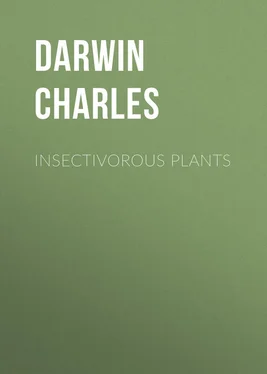Charles Darwin - Insectivorous Plants
Здесь есть возможность читать онлайн «Charles Darwin - Insectivorous Plants» — ознакомительный отрывок электронной книги совершенно бесплатно, а после прочтения отрывка купить полную версию. В некоторых случаях можно слушать аудио, скачать через торрент в формате fb2 и присутствует краткое содержание. Жанр: foreign_antique, foreign_prose, на английском языке. Описание произведения, (предисловие) а так же отзывы посетителей доступны на портале библиотеки ЛибКат.
- Название:Insectivorous Plants
- Автор:
- Жанр:
- Год:неизвестен
- ISBN:нет данных
- Рейтинг книги:5 / 5. Голосов: 1
-
Избранное:Добавить в избранное
- Отзывы:
-
Ваша оценка:
- 100
- 1
- 2
- 3
- 4
- 5
Insectivorous Plants: краткое содержание, описание и аннотация
Предлагаем к чтению аннотацию, описание, краткое содержание или предисловие (зависит от того, что написал сам автор книги «Insectivorous Plants»). Если вы не нашли необходимую информацию о книге — напишите в комментариях, мы постараемся отыскать её.
Insectivorous Plants — читать онлайн ознакомительный отрывок
Ниже представлен текст книги, разбитый по страницам. Система сохранения места последней прочитанной страницы, позволяет с удобством читать онлайн бесплатно книгу «Insectivorous Plants», без необходимости каждый раз заново искать на чём Вы остановились. Поставьте закладку, и сможете в любой момент перейти на страницу, на которой закончили чтение.
Интервал:
Закладка:
It is an important fact that when an organic or inorganic object is placed on the glands of the disc, and the exterior tentacles are thus caused to bend inwards, not only is the secretion from the glands of the latter increased in quantity and rendered acid, but the contents of the cells of their pedicels become aggregated. The process always commences in the glands, although these have not as yet touched any object. Some force or influence must, therefore, be transmitted from the central glands to the exterior tentacles, first to near their bases causing this part to bend, and next to the glands causing them to secrete more copiously. After a short time the glands, thus indirectly excited, transmit or reflect some influence down their own pedicels, inducing aggregation in cell beneath cell to their bases.
It seems at first sight a probable view that aggregation is due to the glands being excited to secrete more copiously, so that sufficient fluid is not left in their cells, and in the cells of the pedicels, to hold the protoplasm in solution. In favour of this view is the fact that aggregation follows the inflection of the tentacles, and during the movement the glands generally, or, as I believe, always, secrete more copiously than they did before. Again, during the re-expansion of the tentacles, the glands secrete less freely, or quite cease to secrete, and the aggregated masses of protoplasm are then redissolved. Moreover, when leaves are immersed in dense vegetable solutions, or in glycerine, the fluid within the gland-cells passes outwards, and there is aggregation; and when the leaves are afterwards immersed in water, or in an innocuous fluid of less specific gravity than water, the protoplasm is redissolved, and this, no doubt, is due to endosmose.
Opposed to this view, that aggregation is caused by the outward passage of fluid from the cells, are the following facts. There seems no close relation between the degree of increased secretion and that of aggregation. Thus a particle of sugar added to the secretion round a gland causes a much greater increase of secretion, and much less aggregation, than does a particle of carbonate of ammonia given in the same manner. It does not appear probable that pure water would cause much exosmose, and yet aggregation often follows from an immersion in water of between 16 hrs. and 24 hrs., and always after from 24 hrs. to 48 hrs. Still less probable is it that water at a temperature of from 125o to 130o Fahr. (51o.6 to 54o.4 Cent.) should cause fluid to pass, not only from the glands, but from all the cells of the tentacles down to their bases, so quickly that aggregation is induced within 2 m. or 3 m. Another strong argument against this view is, that, after complete aggregation, the spheres and oval masses of protoplasm float about in an abundant supply of thin colourless fluid; so that at least the latter stages of the process cannot be due to the want of fluid to hold the protoplasm in solution. There is still stronger evidence that aggregation is independent of secretion; for the papillae, described in the first chapter, with which the leaves are studded are not glandular, and do not secrete, yet they rapidly absorb carbonate of ammonia or an infusion of raw meat, and their contents then quickly undergo aggregation, which afterwards spreads into the cells of the surrounding tissues. We shall hereafter see that the purple fluid within the sensitive filaments of Dionaea, which do not secrete, likewise undergoes aggregation from the action of a weak solution of carbonate of ammonia.
The process of aggregation is a vital one; by which I mean that the contents of the cells must be alive and uninjured to be thus affected, and they must be in an oxygenated condition for the transmission of the process at the proper rate. Some tentacles in a drop of water were strongly pressed beneath a slip of glass; many of the cells were ruptured, and pulpy matter of a purple colour, with granules of all sizes and shapes, exuded, but hardly any of the cells were completely emptied. I then added a minute drop of a solution of one part of carbonate of ammonia to 109 of water, and after 1 hr. examined the specimens. Here and there a few cells, both in the glands and in the pedicels, had escaped being ruptured, and their contents were well aggregated into spheres which were constantly changing their forms and positions, and a current could still be seen flowing along the walls; so that the protoplasm was alive. On the other hand, the exuded matter, which was now almost colourless instead of being purple, did not exhibit a trace of aggregation. Nor was there a trace in the many cells which were ruptured, but which had not been completely emptied of their contents. Though I looked carefully, no signs of a current could be seen within these ruptured cells. They had evidently been killed by the pressure; and the matter which they still contained did not undergo aggregation any more than that which had exuded. In these specimens, as I may add, the individuality of the life of each cell was well illustrated.
A full account will be given in the next chapter of the effects of heat on the leaves, and I need here only state that leaves immersed for a short time in water at a temperature of 120oFahr. (48o.8 Cent.), which, as we have seen, does not immediately induce aggregation, were then placed in a few drops of a strong solution of one part of carbonate of ammonia to 109 of water, and became finely aggregated. On the other hand, leaves, after an immersion in water at 150o (65o.5 Cent.), on being placed in the same strong solution, did not undergo aggregation, the cells becoming filled with brownish, pulpy, or muddy matter. With leaves subjected to temperatures between these two extremes of 120o and 150o Fahr. (48o.8 and 65o.5 Cent.), there were gradations in the completeness of the process; the former temperature not preventing aggregation from the subsequent action of carbonate of ammonia, the latter quite stopping it. Thus, leaves immersed in water, heated to 130o (54o.4 Cent.), and then in the solution, formed perfectly defined spheres, but these were decidedly smaller than in ordinary cases. With other leaves heated to 140o (60 °Cent.), the spheres were extremely small, yet well defined, but many of the cells contained, in addition, some brownish pulpy matter. In two cases of leaves heated to 145o (62o.7 Cent.), a few tentacles could be found with some of their cells containing a few minute spheres; whilst the other cells and other whole tentacles included only the brownish, disintegrated or pulpy matter.
The fluid within the cells of the tentacles must be in an oxygenated condition, in order that the force or influence which induces aggregation should be transmitted at the proper rate from cell to cell. A plant, with its roots in water, was left for 45 m. in a vessel containing 122 oz. of carbonic acid. A leaf from this plant, and, for comparison, one from a fresh plant, were both immersed for 1 hr. in a rather strong solution of carbonate of ammonia. They were then compared, and certainly there was much less aggregation in the leaf which had been subjected to the carbonic acid than in the other. Another plant was exposed in the same vessel for 2 hrs. to carbonic acid, and one of its leaves was then placed in a solution of one part of the carbonate to 437 of water; the glands were instantly blackened, showing that they had absorbed, and that their contents were aggregated; but in the cells close beneath the glands there was no aggregation even after an interval of 3 hrs. After 4 hrs. 15 m. a few minute spheres of protoplasm were formed in these cells, but even after 5 hrs. 30 m. the aggregation did not extend down the pedicels for a length equal to that of the glands. After numberless trials with fresh leaves immersed in a solution of this strength, I have never seen the aggregating action transmitted at nearly so slow a rate. Another plant was left for 2 hrs. in carbonic acid, but was then exposed for 20 m. to the open air, during which time the leaves, being of a red colour, would have absorbed some oxygen. One of them, as well as a fresh leaf for comparison, were now immersed in the same solution as before. The former were looked at repeatedly, and after an interval of 65 m. a few spheres of protoplasm were first observed in the cells close beneath the glands, but only in two or three of the longer tentacles. After 3 hrs. the aggregation had travelled down the pedicels of a few of the tentacles for a length equal to that of the glands. On the other hand, in the fresh leaf similarly treated, aggregation was plain in many of the tentacles after 15 m.; after 65 m. it had extended down the pedicels for four, five, or more times the lengths of the glands; and after 3 hrs. the cells of all the tentacles were affected for one-third or one-half of their entire lengths. Hence there can be no doubt that the exposure of leaves to carbonic acid either stops for a time the process of aggregation, or checks the transmission of the proper influence when the glands are subsequently excited by carbonate of ammonia; and this substance acts more promptly and energetically than any other. It is known that the protoplasm of plants exhibits its spontaneous movements only as long as it is in an oxygenated condition; and so it is with the white corpuscles of the blood, only as long as they receive oxygen from the red corpuscles; 9 9 With respect to plants, Sachs, 'Trait de Bot.' 3rd edit., 1874, p. 864. On blood corpuscles, see 'Quarterly Journal of Microscopical Science,' April 1874, p. 185.'
but the cases above given are somewhat different, as they relate to the delay in the generation or aggregation of the masses of protoplasm by the exclusion of oxygen.
Интервал:
Закладка:
Похожие книги на «Insectivorous Plants»
Представляем Вашему вниманию похожие книги на «Insectivorous Plants» списком для выбора. Мы отобрали схожую по названию и смыслу литературу в надежде предоставить читателям больше вариантов отыскать новые, интересные, ещё непрочитанные произведения.
Обсуждение, отзывы о книге «Insectivorous Plants» и просто собственные мнения читателей. Оставьте ваши комментарии, напишите, что Вы думаете о произведении, его смысле или главных героях. Укажите что конкретно понравилось, а что нет, и почему Вы так считаете.












